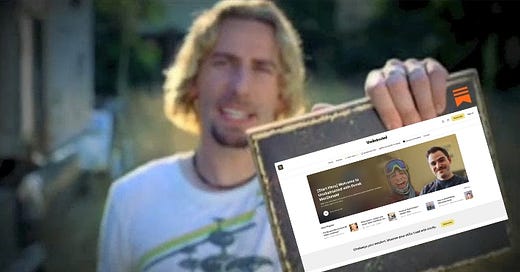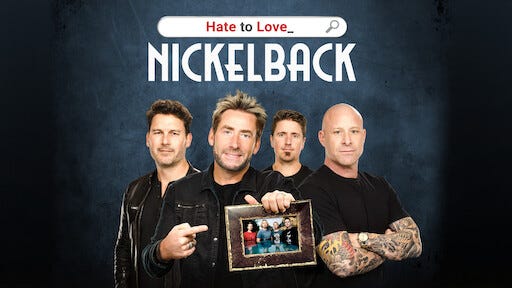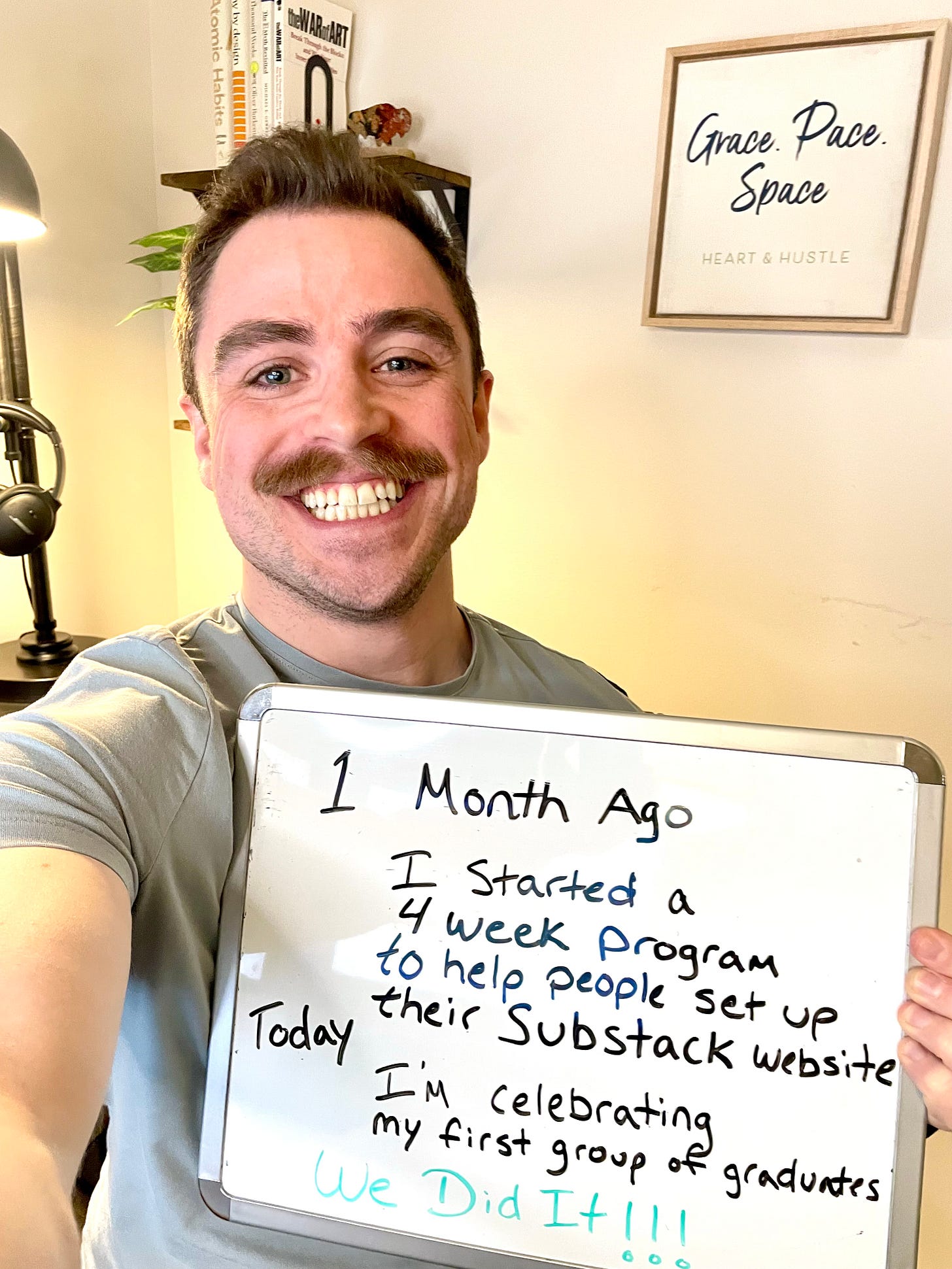LOOK AT THIS SUBJECT LINE... Every Time You Do Nickelback Comes To Mind (Here's Why)
What Nickelback taught you about communication, whether you like it or not.
[Unobstructed Issue No. 062]
You heard those words in song-form. Even if you didn’t want to. Because that damned Chad Kroeger and his merry band of Canadian minstrels did you dirty.
I know, I know… they got me too.
You might be tempted to think they merely captured the zeitgeist of early 2000s pop culture. But they actually taught you something more that you never realized.
Hey. hi. hello.
Welcome back or welcome to Unobstructed.
There’s a popular adage among writers that goes something like, “you can be clear or you can be clever.” Maybe you’ve heard of this one before?
Here’s what it means.
Stand-up comics know that fumbling the set-up to an otherwise fantastic punchline is the difference between landing a Netflix special and watching one from your couch. Because being clear instead of being clever lets people in on the joke before you get to the good part. So they can actually enjoy the good part, with you.
This is what Nickelback taught you.
Well, part of it, anyway. Yeah, sure, whatever you say… you don’t like Nickelback.
Even if that phrase isn’t ringing any bells, you understand the gist of what it’s getting at. Somewhere deep down.
This concept is the reason your joke didn’t land when you met your significant other’s parents for the first time. Not because it wasn’t funny, but because you probably didn’t provide them with enough context to understand.
You can not like Nickelback, but those dudes taught you this lesson better than your high school english teacher did. And if you insist they didn’t, just know that I know what game you’re playing.
Your weekly spotlight.
Here’s what happened.
Like it or not, Nickelback’s hit song Photograph from 2005 makes you nostalgic for memories that are uniquely yours, with words that are specifically theirs.
So how’d they do it?
What made the punchline land so well?
Nickelback let you know what was happening before they told you the story.
Photograph by Nickelback
[Verse 1]
Look at this photograph
Every time I do, it makes me laugh
How did our eyes get so red?
And what the hell is on Joey's head?
And this is where I grew up
I think the present owner fixed it up
I never knew we ever went withoutNotice anything? This pattern is used on repeat, for the duration of every verse, throughout the entire song.
Context
Story
Detail
I’m not criticizing Nickelback’s songwriting here… I’m applauding it. Because it’s so absolutely crystal-clear that you don’t get lost when they start drifting toward clever in the chorus.
[Chorus]
Every memory of looking out the back door
I had the photo album spread out on my bedroom floor
It's hard to say it, time to say it
Goodbye, goodbye
Every memory of walking out the front door
I found the photo of the friend that I was looking for
It's hard to say it, time to say it
Goodbye, goodbyeWithout the framing (lol) you wouldn’t have filled out the shape of the story with your own details, despite the prompting from theirs. Instead, you’d have been trying to wrap your head around the what the words meant.
So what?
Well, here’s what else they taught you.
You can be clear or you can be clever—and, then you can also just… be whatever the f*ck you want.
Describing what’s happening is enough. Yes, really.
A large percentage of the world can recite the lyrics to more than one Nickelback song. And at the same time, Nickelback is arguably the most hated band in history. Netflix even made a documentary about it.
I remember, back in the day, one of the reasons people gave for their hatred was the blunt approach to their lyrics. Nickelback is so clear, in fact, that other people started going viral on platforms like Vine (RIP), just by parodying them. Loosely. Abstractly. Because any reference that landed close enough, was understood. Thanks to Nickelback’s clear, direct delivery.
And, whether you love(d) them or hate(d) them, everyone knew:
who they were.
what their songs were about.
Which gets to the heart of this whole thing. Nickelback showed the whole world that you can be whatever the f*ck you want, so long as you’re clear about it.
So the choice is yours: you can be interpreted or you can be understood.
And when you face the decision of being clear or being clever from now on, you’ll have Nickelback to thank for giving you examples of your options.
All jokes aside, the biggest takeaway from this is that you can show up as you are. And you can share half-baked observations instead of thesis statements. And you should. You don’t have to be able to declare what it means before you’re allowed to share it with people.
Most people feel like they have to do the opposite. Not Nickelback.
Context
Story
Detail
While the exact number of times I listened to Photograph during the writing of this is unknown… I wouldn’t make you read about it and then not share Nickelback’s most notorious, nostalgia-inducing anthem.
Your latest, from my rotation.
watch.
Change Your Life by Journalling - 10 Powerful Questions with Ali Abdaal.
The Secret to Telling a Great Story in Less Than 60 Seconds with Jenny Hoyos at TED.
Your Purpose Statement, Your Resume, And The Little Decisions Along The Way by Timm Chiusano.
listen.
Beyond 10% Happier with Dan Harriss and Rich Roll.
The speaking coach with Jefferson Fisher and Steven Bartlett.
Building Patrón and Paul Mitchell with John Paul DeJoria and Michael Gervais.
read.
How to never run out of ideas by
.You’re not bad at focus. You’ve just been trained out of it by
.Asking for Free Writing Advice is The “Send Nudes” of My Profession by Sean Kernan.
Your latest, from Unobstructed.
Your reading recap.
Your latest episode of The Unobstructed Podcast.
You can also listen on Spotify, Apple Podcasts, and Amazon Music.
Being clear not clever works, as long as you’re still being yourself.
I just re-learned this one.
3 months ago, I knew I needed to pivot.
2 months ago, I started focusing on being clear.
1 month ago, I launched a Substack enablement program.
Today, I have my first group of graduates.
And I have Nickelback to thank. Well, kinda… Let me back up a bit. I could see the problem Substack was facing, I just didn’t know if it was mine to fix. First, let me say that I really enjoy Substack. The platform makes it easy for me to create and maintain both my newsletter and my podcast. And… where Nickelback is clear as glass, Substack is clear as mud.
Here’s what’s happening:
New user joins Substack, ready to publish.
New user hits roadblock, confused by publishing settings.
Which is a pretty big bummer.
And, look, hey: I get it. Seriously. When I moved my still-getting-started newsletter to Substack last year, I had no idea this would happen. Then six months ago, I got laid off. But when I started my own business, I way wayyy over-indexed on trying to sound credible. Can you guess what happened? Exactly! I was too busy being clever to be clear.
So I stopped trying to be heard and focused on just showing up. And that’s how I discovered the big, intimidating, disheartening, preventable problem plaguing most users. I’d met some lovely people on the platform and had formed some great connections. Only later would I discover the issues that no one dared talk about. Because they were embarrassed about it. Substack’s lack of clarity made them feel intimidated.
And, well, that really bothered me.
When you create a Substack, it means building a full website. And that part isn’t clear at all.
Let’s play this out for a minute…
You heard about this new social media platform thing. Maybe a friend told you about it. Or someone sent you an article from a writer on Substack. And you signed up to take a look. “Just what is all this hype about??” you think to yourself.
Well. That’s the clever part. It’s very, very easy to sign up. And that makes you excited. So far so good! But here’s where it isn’t clear—like, not even a little bit.
Creating a Substack site is not like creating a Facebook page, Instagram account, or LinkedIn profile...
On Substack, new users suddenly become:
a writer.
a designer.
a developer.
a site admin.
That's... well c’mon, that's a lot!
So I built a 4 week program designed to simplify the backend of Substack.
It’s called Substack, Simplified and it walks people through clear steps for setting up a Substack website. And then they can get back to enjoying the platform, not troubleshooting its settings.
I’m really excited about it! Because the first group to go through the program graduated this week!
A recent grad, Kim, described it like this:
"Being somewhat tech-savvy, I wasn’t sure I needed Substack, Simplified, but I did. I really did...It saved me countless hours."
This wouldn’t have been possible had I not stopped trying to be clever, and focused instead on being clear. That’s also what led me to… being whatever the f*ck I want.
Just look at this photograph.
onward.
-dmac
P.S. Trying to make sense of your Substack site settings? Use this free checklist to try the 5 Ps framework.
P.P.S. If the weekly newsletter’s helping you think differently, a paid subscription’s where we can put it into practice.
You get:
Monthly longer-form essays.
Behind-the-scenes systems access.
First dibs & discounts on new resources.













I'll have the quesadilla.
Hubba, Hubba.
Good stuff. And while not a fan, never have quite gotten the Nickelback hate (Creed, yeah, totally get that given that dude sings like he's constipated).
Genius article. So well written. So many incredible resources listed. 🤯👏👏